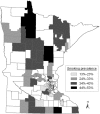Area-level variation in adolescent smoking
- PMID: 19288985
- PMCID: PMC2687848
Area-level variation in adolescent smoking
Abstract
Introduction: The purpose of this study is to 1) examine the variability in the prevalence of adolescent smoking in 60 geographic areas of Minnesota and 2) assess how variability in area-level smoking prevalence is associated with area-level sociodemographic characteristics.
Methods: Smoking data were collected from 3,636 adolescents residing in 60 areas of the state of Minnesota. Area-level characteristics were obtained from the 2000 US Census. Coefficient of variation was calculated to assess variability in smoking prevalence across areas, and mean smoking prevalence was compared above and below the median for each area-level characteristic.
Results: Substantial variation was found in adolescent smoking prevalence rates. Across the 60 areas, the percentage of adolescents that ever smoked varied from 13% to 53%, and the percentage of adolescents that smoked in the past 30 days ranged from 3% to 19%. Mean lifetime smoking prevalence was higher in areas with a higher percentage of residents with less than a high school education, a lower percentage of residents living in an urban area, lower median housing value and a lower median household income, a higher percentage of residents aged 16 years or older who were unemployed, and a higher percentage of residents with an income-to-poverty ratio less than 1.5. Similar results were found for past 30-day smoking prevalence among girls; however, no area-level characteristics were significantly associated with past 30-day smoking prevalence among boys.
Conclusion: Results suggest that area-level characteristics may play an important role in adolescent smoking, particularly for girls.
Figures
References
-
- Johnston LD, O'Malley PM, Bachman JG, Schulenberg JE. Monitoring the future national results on adolescent drug use: overview of key findings. Bethesda (MD): US Department of Health and Human Services, National Institute on Drug Abuse; 2006.
-
- Wilcox P. An ecological approach to understanding youth smoking trajectories: problems and prospects. Addiction. 2003;(98 Suppl 1):57–77. - PubMed
-
- Sustaining state, programs, data highlights. Sustaining state programs for tobacco control, data highlights. Atlanta (GA): Centers for Disease Control and Prevention; 2006.
-
- Northridge ME, Morabia A, Ganz ML, Bassett MT, Gemson D, Andrews H, et al. Contribution of smoking to excess mortality in Harlem. Am J Epidemiol. 1998;147(3):250–258. - PubMed
Publication types
MeSH terms
Grants and funding
LinkOut - more resources
Full Text Sources
Medical
Miscellaneous


